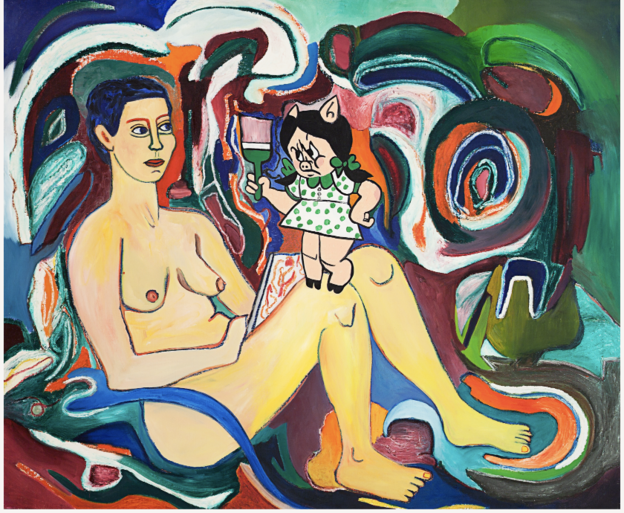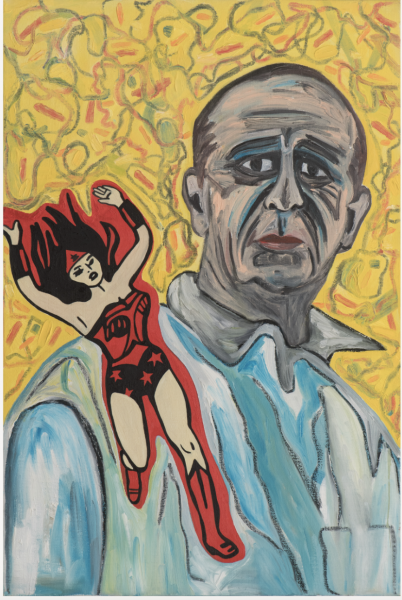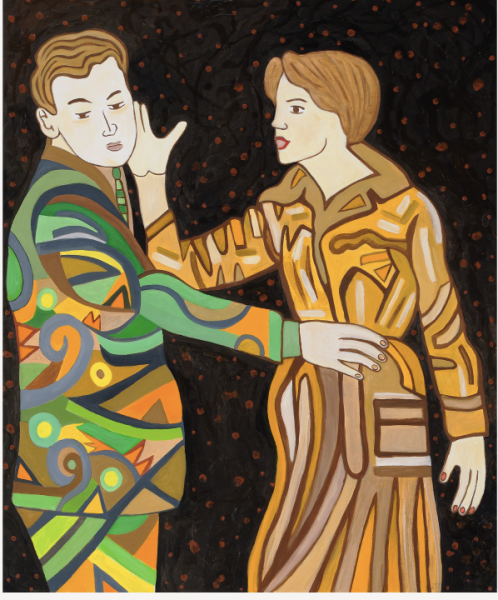
A Conversation between Susan Bee and Tim Barry

Susan Bee's Provincetown museum show closed today. This interview is being published to mark the occasion.
Tim Barry: Susan, I am very familiar with your work, as I showed you and your great friends, the wonderful artists Mimi Gross and Mira Schor, at my bookshop in Provincetown in 2016 in the show: “Three Friends.” So, congratulations on your first museum retrospective! The editor at Artsfuse, Bill Marx, recently saw the exhibition and noted that his initial take on your show was that it uses folk art and outsider art imperatives “to explore issues of feminism, among others.” Is this accurate?
 Susan Bee: That’s a bit boiled down, as there are also seascapes …. The show covers a range of territory. There are 31 paintings, there’s also a case of books, including collaborations with poets Charles Bernstein and Jerome Rothenberg, and a unique leporello. There are landscapes, there’s pop history paintings –– such as “Framing the Rosenbergs” (1983) and “Marsden Hartley Meets Wonder Woman” (1983) [pictured left]. Some of the paintings are political and involved with feminism. There are collaged paintings that are very Pop. I use film noir images and slogans.
Susan Bee: That’s a bit boiled down, as there are also seascapes …. The show covers a range of territory. There are 31 paintings, there’s also a case of books, including collaborations with poets Charles Bernstein and Jerome Rothenberg, and a unique leporello. There are landscapes, there’s pop history paintings –– such as “Framing the Rosenbergs” (1983) and “Marsden Hartley Meets Wonder Woman” (1983) [pictured left]. Some of the paintings are political and involved with feminism. There are collaged paintings that are very Pop. I use film noir images and slogans.
Can you talk a little bit about your journey toward art-making?
My parents, Sigmund Laufer and Miriam Laufer were both artists. On Saturdays my father would take me into his print-making studio at Pratt to work with him and my mother would put me in a corner of her studio with paints and paper. I was immersed in art and artists.
Did you later go to art school?
I studied art history and art at Barnard. I did take art classes at MOMA as a child. Then I went to the High School of Music and Art, in Manhattan. I got an MA in Art at Hunter College, where I studied with minimalists.
When did you have your first solo show?
It was late –– in 1992. I was 40. The show was at the Virginia Lust Gallery in Soho. Virginia’s main interests were the Surrealists. She represented Hans Bellmer, June Leaf, and Giacometti.
Do you consider yourself a Surrealist?
I love Surrealism. But Surrealism is dead.
So yes or no, are you a Surrealist?
I look at everything. My last show at A.I.R. Gallery was based on medieval Apocalypse manuscripts. Caspar David Friedrich, the German Romantic painter, James Ensor, Marsden Hartley –– those are my guys. That’s why I’m not a feminist [laughs]. . . . It’s not that I’m not a feminist! I just get a lot from these guys.
I can see the Marsden Hartley connection; in terms of what your work looks like, it’s sort of a de-skilling, not very finished look.
That’s what I like about Hartley, he’s very emotional and he’s very direct. Kind of in-your-face direct.
 “The Slap” (2012) [pictured right] reminds me of Alex Katz.
“The Slap” (2012) [pictured right] reminds me of Alex Katz.
Possibly. This one of mine is based on a film still.
How do you differ from Alex Katz?
I feel like I have a lot more content. I’m more concerned with politics and history
Bright colors, a lot going on, some cartoonish images.
I love bright colors. Maybe I’m more of a narrative painter or a storyteller. Every single painting of mine has a story to it. But you don’t have to know all of the back-stories. I see people in the galleries looking at the work who don’t know anything about it.
Well, every painting has a story to tell.
For example, one of mine has me in front of the orphanage where my mother grew up in Berlin, “Ahava, Berlin” (2012). But you can view it without knowing the full story behind the image.
To switch gears for a minute . . . What do you see as the function of 2-dimensional visual art, in this digital age, paintings and drawings, going down the road?
A lot of my work is online. I’ve sold work to people who only saw the images online. I have artist friends who only make work online. So, I don’t know . . . but what’s lost for me is you don’t have a sense of the scale, and the texture of the paint. It’s a little frustrating, but on the other hand it gives a lot of people access to the work.
Can you offer any advice to people starting out making art, whether a teenager, or in art school, or even an older person just starting out?
Drawing, draw all the time. I would go to the Life Drawing Class at the Provincetown Art Museum as a child, and they still have it, and I think I learned a lot from having to draw from the nude . . . it’s a discipline. You don’t need to start as an oil painter. Draw, sketch, use crayons, pencil, acrylics and watercolors.
I notice quite a bit of a Frida Kahlo influence. How important to you is she as a model?
I was influenced by Frida Kahlo. I do love her self-portraits, which I saw in the early 80s. We went to her house in Mexico City in 1983, when I painted the self-portraits in the show: “Doomed to Win” and “Portrait of the Artist as a Young Pig.” I also wrote a review of the biography of her by Hayden Herrera in 1984. I also love the Mexican muralists, who are a great influence on my work.
Provincetown, September 15, 2024
Susan Bee: The Eye of the Storm: Selected Works 1981-2023
Curated by Johanna Drucker
Provincetown Art Association and Museum
Provincetown, Mass., Aug. 23-November 17, 2024
Tim Barry is the proprietor of Tim’s Books in Provincetown (& always on the lookout to buy collections)